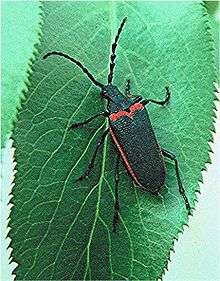Lepturinae
| Lepturinae | |
|---|---|
 | |
| Central European Lepturini and Rhagiini with some anatomical details | |
| Scientific classification | |
| Kingdom: | Animalia |
| Clade: | Euarthropoda |
| Class: | Insecta |
| Order: | Coleoptera |
| Family: | Cerambycidae |
| Subfamily: | Lepturinae |
| Diversity | |
| 5–7 tribes About 150 genera | |
| Synonyms | |
|
Dérécéphalides Mulsant, Lepturadae Samouelle, Lepturida Leach, Lepturidae Stephens, Lepturides Mulsant, Lepturites Newman, Lepturetae Latreille | |
Lepturinae, the lepturine beetles, is a subfamily of the longhorn beetle family (Cerambycidae), containing about 150 genera worldwide. This lineage is most diverse in the Northern Hemisphere. Until recently the subfamily Necydalinae was included within the lepturines, but this has been recently recognized as a separate subfamily. At least 5 tribes are usually recognized today; some authors have proposed additional ones, but at least some of them appear to be invalid. A few genera are of uncertain placement within the subfamily.
Usually among the smaller members of their family, these beetles are of a slender shape – particularly the thorax is markedly less wide than the wings, while the elytra tips are often pointed. They differ from most other longhorn beetles in that the antennae are not directly adjacent to the compound eyes. Hence, the latter are generally oval in outline, rather than having an indentation where the antennae originate, or even being divided by them. In addition, sexual dichromatism is not infrequently seen in lepturines; usually, longhorn beetles are not dimorphic or only have longer antennae in males.
Tribes and genera
Lepturinae contains the following genera:[1]

_(3636411046).jpg)